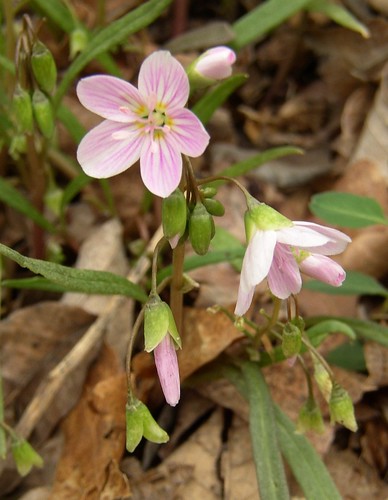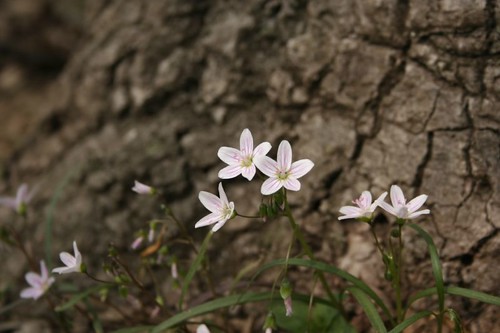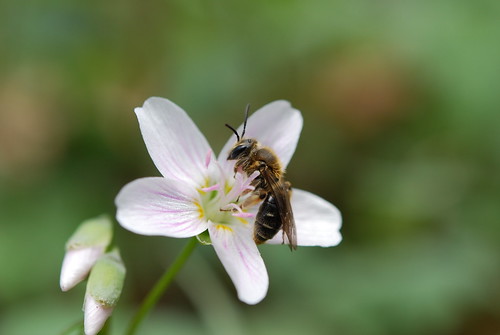Spring beauties are not a showy flower, but we find their little blooms dainty and adorable. They're one of the first to bloom among the flowers called spring ephemerals: perennial flowers that emerge every spring on the forest floor, before the trees leaf out, then fade into the background (or die back entirely to the ground) until next spring. They're also one of the longer-lasting blooms, so you've got a wider window of opportunity to find them.
We actually start looking for spring beauties in January. Not the flowers, but the little leaves. They're skinny like a little blade of grass, but more succulent -- spring beauties are actually related to purslane. (And like purslane, the leaves are edible.)
By mid-March, the spring beauties are blooming. The flowers are small (maybe 3/4" wide) and low to the ground -- the entire plant usually doesn't grow any taller than 4 to 6 inches. At any other time of year, they'd be easy to overlook. In early spring, though, they're a major part of the show before other things start blooming.
The flowers have 5 petals that can be white or light pink. If you look closely, you'll see they're candy-striped with thin pink lines pointing to the center of the flower. And just in case that doesn't tip off the pollinators well enough, the center opening of the flower is highlighted with little yellow spots.
Watch for how the flowers react to the weather. On a sunny day, they'll open wide. But with clouds, the petals fold back up and wait for better weather. It's another thing we love about these plants.
By early summer, the flowers and leaves of spring beauty will shrivel up and die back to the ground. But several inches below the ground, the plant is storing energy for next spring in a little corm that can be as much as 6 inches underground. We've heard these tubers called fairy spuds -- they're starchy and edible when cooked, but each one is tiny. It would take an awful lot of energy to dig up enough fairy spuds to make any kind of meal. But apparently Native Americans and early colonists found them excellent.
We've tried a few fairy spuds from our yard -- but I think I prefer to see the flowers.
In the woods: Spring beauties can be prolific where they're not overgrazed by deer. We've come across areas that are carpeted with them, especially on hillsides where it's harder for deer to stop for a succulent snack. They'll bloom first on slopes that face south.
In your yard: We love the spring beauties we've planted in a shady spot in our backyard. They're a great reminder to get out into the woods and see what else is coming up.
Do you like our LOOK FOR posts? Want to let others know about the Natural Capital?
Vote for us in the City Paper's "Best of DC" poll!
skip to main |
skip to sidebar
Recent Posts
Popular
Car-Free DC: Ten Great Places to Hike Around DC by Public Transportation (and Counting)
Car-Free DC: Rock Creek Park
LOOK FOR: Monarch Caterpillars (and Raise Them!)
Getting Kids Into Nature: Great Websites
Car-Free DC: Glover Archbold Park
LOOK FOR: Sumac Berries
Scott's Run Nature Preserve
Attachment to Nature Parenting: 10 Tools to Give Kids a Passion for Nature
Patuxent River Park: Jug Bay Natural Area
Car-Free DC: Rock Creek Park
LOOK FOR: Monarch Caterpillars (and Raise Them!)
Getting Kids Into Nature: Great Websites
Car-Free DC: Glover Archbold Park
LOOK FOR: Sumac Berries
Scott's Run Nature Preserve
Attachment to Nature Parenting: 10 Tools to Give Kids a Passion for Nature
Patuxent River Park: Jug Bay Natural Area
Comments
Links & Tweets
Twitter Updates
Calendar
We don't check for updates - you may want to check in with the trip leaders or sponsoring organizations!
Key: volunteering - kids & families - everything else
Archive
-
▼
2010
(34)
-
▼
March
(13)
- LOOK FOR: Bloodroot, a Delicate White Flower with ...
- C&O: the McKee-Beshers Wildlife Management Area
- Calendar: Learn About Native Plants, and Buy Some
- LOOK FOR: Spicebush Flowers, North America's Answe...
- Learn Your Wildflowers and Wild Edibles: Sign Up f...
- Calendar: The Potomac Heritage Trail
- LOOK FOR: Fairy Spuds, More Commonly Known as Spri...
- In pictures: Waiting for Spring
- Environmental Film Festival: March 16-28
- Calendar: Visit Two Threatened Creeks
- LOOK FOR: Yellow-Bellied Sapsuckers
- In Pictures: Thaw
- New & Improved Natural Capital: Thanks for Your Fe...
-
▼
March
(13)






